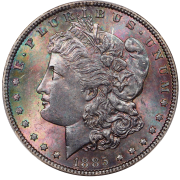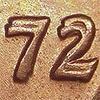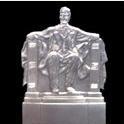Just as a preface, I haven't posted anything to the forums in awhile, but I have been following it silently on and off over the past few years. Over that time, I have been experimenting with some different ways to conserve coins, trying to think outside the box and try some unique solutions. This is the first method that actually produced surprisingly good results, and it only uses one cheap ingredient: glue. It sounds crazy, normally glue is something that is contaminating the surface of a coin, but in this case, I have found a way to potentially use it to remove surface contaminants and junk off the coin face. NOTE: this is experimental and should not be used on any valuable coins that have any remote value.
For these experiments, I have been using Elmer's glue, and simply covering one of the faces of the coin completely and then letting it dry. This glue hardens in a uniform sheet, and doesn't adhere to metal very well, making it a perfect candidate for work on coins. Once it is dry, just peel the hardened layer of glue off the coin to reveal all the crud it removed (purposely applying some glue over the edge of the coin as a lip to peel from helps tremendously in the removal process, just place the coins on wax paper so it is easy to lift the coins off from). Most of the coins I have experimented with have shown improvements, but each application only removes one layer of junk from a coin, so if there are many layers built up then it might take multiple applications to remove it all. That being said, I photographed 10 coins before and after one round of treatment. The camera and lighting were in the exact same spot for both shots, the settings were set on manual and were kept the same (including manual white balance), and there was no doctoring of any kind afterwards on the computer. All I did to the images was place them side-by-side and added some text so it was clear which one was the before coin and which one was the after. I attempted to choose some coins that have a relatively small amount of crud, and some that would normally go straight in the rejects bin. Out of all of them, the 1960-D and 1997-P showed the most improvement.
Some of the downsides I have noticed are that it does effect the color of bright red coins (as seen on the 1979-P shot). It also produced some awful toning on a bu shield cent that I used as one of my first test subjects (didn't photograph). That being said, let me know what you think, and even though Elmer's glue might not be the best choice, maybe there is another type that would work better?
Welcome guest, is this your first visit? Click the "Create Account" button now to join.
Results 1 to 10 of 10
-
03-14-2019 #1
New coin cleaning method that works surprisingly well!
-
Post Thanks / Like - 4 Thanks, 7 Likes
-
03-14-2019 #2
I am intrigued!! Thanks for the information!
 Have you tried on a woody?
Have you tried on a woody?
-
Post Thanks / Like - 2 Thanks, 2 Likes
-
03-14-2019 #3
This is an interesting experiment drex! There is a big difference on the 1960D and 1997P! It even seemed to remove most of the gunk on the obverse motto of the 51D! I wonder what BadThad would think about the composition of glue like Elmers or other types of glue and the affect it may have on the patina? I am wondering because you said it caused an awful toning on the BU Shield and the red 1979P so like you said that is a downside if it's going to mess with red coins. I'm curious... did you leave the glue on the coins for the same amount of time?
-
Post Thanks / Like - 0 Thanks, 3 Likes
-
03-14-2019 #4
On all these coins, I left the glue on overnight. However, on the shield cent, I only did half of the coin just to see the before and after in real life. For some reason, some of the glue on the outside of the hardened clump would not harden, and that is where the toning appeared. More testing is required before making a concrete conclusion.
Also makecents, I have not tried this on a woody yet. All of my woodies are in 2x2's and in fairly nice shape (I don't keep them otherwise, there would be too many ). However, once I do find another one I will try this on it.
). However, once I do find another one I will try this on it.
-
Post Thanks / Like - 2 Thanks, 3 Likes
-
03-14-2019 #5
Pretty interesting research. However, the very fact that it changes the color (in a couple of cases, significant changes) would make it a process that is greatly frowned upon. I do like the fact that you tried it on everything, and that you went 'outside the box' with the research. I think this may be a good process ONLY for damaged coins or other coins you don't care too much about.
Bob Piazza
Former Lincoln Cent Attributer Coppercoins.com
-
Post Thanks / Like - 4 Thanks, 5 Likes
-
03-14-2019 #6
Interesting. All coin stains are different, it might work very well on certain ones and not at all on others.
You can't fix corrosion or rotted zincs, the place this matters the most for (to me) is when you have an otherwise ok coin but maybe has some black stuff around the details.
I've hear of people using temperature cycling to help loosen hard stuff, freeze a coin then warm it in hot water and repeat then the stuff is easier to get off. That might help, then the glue might be used to get it off.
-
Post Thanks / Like - 2 Thanks, 3 Likes
-
03-15-2019 #7
I would totally agree with this. At least, until a better solution may be found. I haven't tested any other types of glue yet to see how they affect the coin, but who knows, there may be a way to eventually make this work better. For now though, you are right, just thought it was pretty interesting and had some very surprising results.
-
Post Thanks / Like - 1 Thanks, 1 Likes
-
03-15-2019 #8
Drex, did you soak the coins in acetone before applying the glue? I wonder if the Shield had some kind of oily substance on it that caused the glue to not harden and dry up. Your experiment reminds me of when I was a kid, we would spread Elmer's glue on our hands, wait for it to dry and peel it off LOL! I don't know if there are other glues that would peel off like Elmer's. Gorilla glue and Super Glue types would be stuck on there forever!
-
03-16-2019 #9
No, I didn't soak it in anything before hand. I had set it aside as one of the nicer 2018's from my recent penny box. Here is a picture of the obverse, I applied the glue twice, once to the right half of the coin, and once in a strip down the middle (which is clearly seen). It perplexes me why it only did it on the right side and not the left.
-
Post Thanks / Like - 1 Thanks, 1 Likes
-
03-16-2019 #10








 Reply With Quote
Reply With Quote








Bookmarks